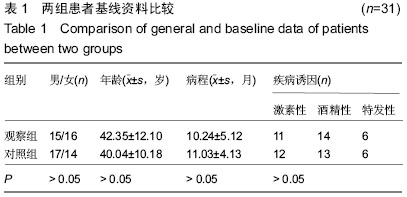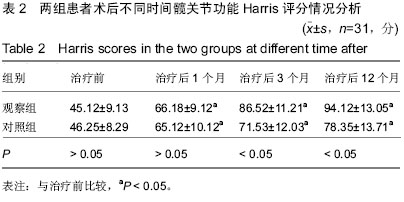| [1] 徐鸿尧,赵建宁,郭亭,等.纳米羟基磷灰石/聚酰胺66骨支撑材料与钽棒置入修复早期股骨头坏死:近期效果比较[J].中国组织工程研究,2014,18(39):6292-6297.
[2] 胡庆柳.仿松质骨的胶原/纳米羟基磷灰石人工骨治疗免股骨头坏死的动物实验[J].中国组织工程研究与临床康复,2009,13(21): 4093-4097.
[3] Jiang L,Sun H,Yuan A,et al.Enhancement of osteoinduction by continual simvastatin release from poly(lactic-co-glycolic acid)-hydroxyapatite-simvastatin nano-fibrous scaffold.J Biomed Nanotechnol.2013;9(11):1921-1928.
[4] 雷鸣.血管化聚-DL-乳酸/纳米羟基磷灰石复合多孔支架修复兔股骨头坏死的实验研究[D].华中科技大学,2010.
[5] 迮仁浩.VEGF转染MSCs结合PLA/HA多孔支架治疗兔早期股骨头坏死的实验研究[D].华中科技大学,2010.
[6] 吕玉明.混合附载内皮细胞与成骨细胞的纳米晶重组类人胶原基/聚乳酸修复骨坏死的实验研究[D].南方医科大学,2011.
[7] 李瑞琦.液态纳米组织工程骨对兔实验性股骨头缺血性坏死修复作用的实验研究[D].河北医科大学,2012.
[8] 张颖,刘又文,魏秋实,等.AVN钽棒置入与带旋髂深血管蒂髂骨瓣移植治疗股骨头坏死的早期疗效对比[J].中国矫形外科杂志, 2011,19(15):1311-1315.
[9] 张利,李玉宝,周钢,等.纳米羟基磷灰石/壳聚糖复合骨水泥的固化机理研究[J].无机材料学报,2006,21(5):1197-1202.
[10] 尤福,李吉东,左奕,等.浆料粘度对纳米羟基磷灰石/聚酰胺66复合支架孔结构与力学性能的影响[J].功能材料,2012,43(6): 798-802.
[11] Amir Nemati Hayati,H.R. Rezaie,S.M. Hosseinalipour,et al. Preparation of poly (3-hydroxybutyrate)/nano- hydroxyapatite composite scaffolds for bone tissue engineering.Mater Lett. 2011;65(4):736-739.
[12] 陈景帝,王迎军,陈晓峰,等.利用冷冻干燥原位构筑仿生型纳米羟基磷灰石、壳聚糖多孔支架材料[J].稀有金属材料与工程,2009, 38(z3):271-273.
[13] 张利,李玉宝,魏杰,等.纳米羟基磷灰石/壳聚糖复合骨修复材料的共沉淀法制备及其性能表征[J].功能材料,2005,36(3): 441-444.
[14] 王立新,袁峰,万怡灶,等.纳米羟基磷灰石/细菌纤维素复合组织工程支架的细胞毒性和生物相容性[J].中国组织工程研究,2014, 18(47):7615-7620.
[15] 黄艳霞,陈楚,任杰,等.聚乳酸-羟基乙酸/改性纳米羟基磷灰石复合多孔支架材料的研制[J].功能材料,2007,38(4):629-632.
[16] 蒋柳云,李玉宝,张利,等.纳米羟基磷灰石/壳聚糖/羧甲基纤维素三元复合骨修复材料的制备和性能研究[J].功能材料,2007, 38(5):798-801.
[17] 李斯日古楞,胡晓文.纳米羟基磷灰石/明胶仿生复合材料的制备及其细胞相容性[J].中南大学学报:医学版,2014,39(9): 949-958.
[18] Hayati AN,Rezaie HR,Hosseinalipour SM,et al.Preparation of poly(3-hydroxybutyrate)/nano-hydroxyapatite composite scaffolds for bone tissue engineering.Mater Lett.2011;65(4): 736-739.
[19] 刘爱红,孙康宁,赵冬梅,等.纳米羟基磷灰石/羧甲基壳聚糖多孔生物复合材料的制备与性能研究[J].人工晶体学报,2007,36(2): 276-280,284.
[20] 李景峰,郑启新.纳米羟基磷灰石仿生骨材料的研究进展[J].国际生物医学工程杂志,2011,34(4):235-239.
[21] 叶鹏,田仁元,黄文良,等.丝素/壳聚糖/纳米羟基磷灰石构建的骨组织工程支架[J].中国组织工程研究,2013,17(29): 5269-5274.
[22] 谭羽莹,邵英,李玉新,等.改性纳米羟基磷灰石/聚乳酸-聚羟乙酸复合骨髓基质干细胞修复兔桡骨缺损[J].中国组织工程研究, 2012,16(21):3843-3846.
[23] 杨建平,谢国华,薛峰,等.多孔细针髓心减压及钽棒支撑植入治疗早期股骨头坏死的疗效比较[J].山东医药,2012,52(9):79-80.
[24] 史筱璐,刘立中,谢凤莲,等.豚鼠骨髓间充质干细胞与纳米羟基磷灰石体外构建组织工程人工听骨[J].中国组织工程研究与临床康复,2011,15(8):1345-1349.
[25] 李家锋,崔群,孙秀英,等.纳米羟基磷灰石/聚己内酯电纺支架修复种植体周围骨缺损[J].中国组织工程研究,2014,18(16): 2557-2562.
[26] Mishra D,Bhunia B,Banerjee I,et al.Enzymatically crosslinked carboxymethyl-chitosan/gelatin/nano- hydroxyapatite injectable gels for in situ bone tissue engineering application. Mat Sci Eng C-Bio S.2011;31(7):1295-1304.
[27] Tavakol S,Kashani IR,Azami M,et al.In vitro and in vivo investigations on bone regeneration potential of laminated hydroxyapatite/gelatin nanocomposite scaffold along with DBM.J Nanopart Res.2012;14(12):1265.
[28] 杨萌,陈民芳,王昊,等.骨修复用纳米羟基磷灰石/聚酰胺66的体内外生物相容性[J].中国组织工程研究与临床康复,2010,14(8): 1513-1516.
[29] 宋坤修,何爱咏,谢求恩,等.纳米羟基磷灰石/胶原复合材料结合血管内皮生长因子修复兔桡骨缺损[J].中国组织工程研究与临床康复,2009,13(34):6624-6628.
[30] 马元琛,廖俊星,林桢,等.钽棒与髓芯减压植骨治疗早中期股骨头坏死的疗效比较[J].广东医学,2014,35(13):2101-2103.
[31] 佟刚,赵鉴非,戴军,等.多孔重建钽棒内固定治疗早期股骨头坏死疗效观察与分析[J].中国骨与关节损伤杂志,2012,27(10): 882-884.
[32] 刘耀升,刘蜀彬,周诗国,等.改良钽棒技术治疗股骨头坏死的生存率及预后因素分析[J].中华医学杂志,2014,94(31):2429-2433.
[33] Tavakol S,Nikpour MR,Amani A,et al.Bone regeneration based on nano-hydroxyapatite and hydroxyapatite/chitosan nanocomposites: an in vitro and in vivo comparative study.J Nanopart Res.2013;15(1):1373.
[34] Fricain JC,Schlaubitz S,Le Visage C,et al.A nano-hydroxyapatite - Pullulan/dextran polysaccharide composite macroporous material for bone tissue engineering.Biomaterials.2013;34(12):2947-2959.
[35] Wang F,Zhang YC,Zhou H,et al.Evaluation of in vitro and in vivo osteogenic differentiation of nano-hydroxyapatite/chitosan/poly(lactide-co-glycolide) scaffolds with human umbilical cord mesenchymal stem cells.J Biomed Mater Res A. 2014;102(3):760-768.
[36] Qu YL,Ao DT,Wang P,et al.Chitosan/nano-hydroxyapatite composite electret membranes enhance cell proliferation and osteoblastic expression in vitro.J Bioact Compat Pol.2014; 29(1):3-14.
[37] 宫宁基,王韶进,刘文广,等.髓芯减压多孔钽棒植入术与带蒂股方肌肌骨瓣移植术治疗Ficat Ⅱ期成人股骨头坏死的疗效比较[J].山东大学学报:医学版,2010,48(7):99-101.
[38] 苏保,李吉东,蒋电明等.聚氨酯/纳米羟基磷灰石/聚酰胺66股骨髁修复犬骨软骨缺损的实验研究[J].功能材料,2013,44(4): 493-497.
[39] 彭超,郭忠鹏,蒋电明,等.聚氨酯/纳米羟基磷灰石+聚酰胺66一体化复合支架材料修复软骨及软骨下骨缺[J].中国组织工程研究与临床康复,2010,14(16):2883-2887.
[40] 王菲,周洪,郭昱成,等.纳米羟基磷灰石/壳聚糖/聚丙交酯支架的体外生物相容性和成骨活性[J].中国组织工程研究,2014,18(8): 1198-1204.
|


